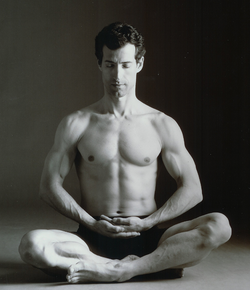
1. To start, find a quiet place - away from noise, bright lights, or other distractions. Turn off your phones so you won't be disturbed. Sit on a cushion with your legs crossed or on a straight back chair with your feet flat on the floor. Place your hands palms up on your thighs and find a balanced position with a straight spine. If you need, place another cushion behind your lower back for support. It is important that you feel comfortable and safe in your space for meditation to be most effective.
2. Close your eyes and listen to your breath. Feel the easy ebb of flow of air in and out of your body and feel a steady stillness in your body. Shrug your shoulders up, then exhale and let them drop. Relax your chest and sink your hips down like roots to the earth. Now begin to "observe" your breath. Do not try to control it yet, just notice the inhalation and exhalation and how each phase of the breath moves the body. Noticing the breath is the first way we bring our focus inward and our attention to the present. It is called "conscious breathing". In yoga, the breath represents "prana" which can be thought of as universal energy that permeates the universe, connecting all things to the divine spirit.
3. Staying with your focus on your breath, begin to lengthen your exhales. Feel your inhalation begin with the diaphragm (located under your ribs in the center of the body called the thorax). Deepen your breathing slightly, without forcing it. Just follow all the air out, patiently waiting until you are truly empty, then feel your inhalation start from a deeper place. Allow the muscles of your forehead, cheeks, and jaw to relax. Soften your eyes and your mouth. With practice, you can let your body and your consciousness float on your breath. Feel lifted and supported with your breath. Stay with your breath in this way for 10 full cycles of the breath.
4. There are many ways to use visualizations to help create inner calm and peace. Here is an example: As you look inward, visualize your mind as empty space, dimly illuminated like a gray cavern. If extraneous thoughts or images pop up into your consciousness, just notice them as separate from you, like floating objects that eventually drift away and disappear. Visualize the grayness like foggy clouds in space. Next, with the tempo of the breath, start to sweep away the clouds with each breath. From behind and above the gray clouds is clear sky and pure light. After all the grayness is swept away, allow your mind to become illuminated with this clear blue, empty sky. Sense the source of the light reflected in the sky as coming from within your heart center. Starting like the sun just poking up from the horizon, it slowly fills up in your heart/mind and the sky is expanded to the heavens. You are now filled with the aura of your divine being. It shines out from the top of your head and surrounds you with a protective layer of peaceful and loving light energy. You do not feel anymore than this; it is a natural, calming, and content feeling. Pure emptiness in the mind frees your heart source. It is ok if strong emotions come to the surface while you meditate. You may start to cry or feel sad. This is normal as your body may need to let go of fear or emotional stress. It is natural, healthy, and will pass. Return to your breath and just enjoy the emptiness and relaxed state of being in the present - in your space - centered, calm, aware.
5.There are many books on how to meditate and how to expand it's benefits. Some of our favorites are:
-"Simple Meditation and Relaxation" (Simple Wisdom Book) by Joel Levy and Michele Levy.
"Wherever You Go, There You Are: Mindfulness Meditation in Everyday Life", by Jon-Kabat Zinn
-"The Power of Now" by Eckhart Tolle.


 RSS Feed
RSS Feed
